
John Wilkins was an Anglican clergyman, natural philosopher, and author, and was one of the founders of the Royal Society. He was Bishop of Chester from 1668 until his death.

Thomas Sprat, FRS was an English churchman and writer, Bishop of Rochester from 1684.

The Royal Society, formally The Royal Society of London for Improving Natural Knowledge, is a learned society and the United Kingdom's national academy of sciences. The society fulfils a number of roles: promoting science and its benefits, recognising excellence in science, supporting outstanding science, providing scientific advice for policy, education and public engagement and fostering international and global co-operation. Founded on 28 November 1660, it was granted a royal charter by King Charles II as The Royal Society and is the oldest continuously existing scientific academy in the world.

William Brouncker, 2nd Viscount Brouncker FRS was an Anglo-Irish peer and mathematician who served as the president of the Royal Society from 1662 to 1677. Best known for introducing Brouncker's formula, he also worked as a civil servant, serving as a commissioner in the Royal Navy. Brouncker was a friend and colleague of Samuel Pepys, and features prominently in the Pepys' diary.

Invisible College is the term used for a small community of interacting scholars who often met face-to-face, exchanged ideas and encouraged each other. One group that has been described as a precursor group to the Royal Society of London consisted of a number of natural philosophers around Robert Boyle, such as Christopher Wren. It has been suggested that other members included prominent figures later closely concerned with the Royal Society; but several groups preceded the formation of the Royal Society, and who the other members of this one were is still debated by scholars.
Sir Robert Moray FRS was a Scottish soldier, statesman, diplomat, judge, spy, and natural philosopher. He was well known to Charles I and Charles II, and to the French cardinals Richelieu and Mazarin. He attended the meeting of the 1660 committee of 12 on 28 November 1660 that led to the formation of the Royal Society, and was influential in gaining its Royal Charter and formulating its statutes and regulations. He was also one of the founders of modern Freemasonry in Great Britain.

William Croone was an English physician and one of the original Fellows of the Royal Society.

Theodore Haak was a German Calvinist scholar, resident in England in later life. Haak's communications abilities and interests in the new science provided the backdrop for convening the "1645 Group", a precursor of the Royal Society.

Ralph Bathurst, FRS was an English theologian and physician.

The Hobbes–Wallis controversy was a polemic debate that continued from the mid-1650s well into the 1670s, between the philosopher Thomas Hobbes and the mathematician and clergyman John Wallis. It was sparked by De corpore, a philosophical work by Hobbes in the general area of physics. The book contained not only a theory of mathematics subordinating it to geometry and geometry to kinematics, but a claimed proof of the squaring of the circle by Hobbes. While Hobbes retracted this particular proof, he returned to the topic with other attempted proofs. A pamphleteering exchange continued for decades. It drew in the newly formed Royal Society, and its experimental philosophy to which Hobbes was opposed.
Matthew Wren was an English politician and writer. He is now known as an opponent of James Harrington, and a monarchist who made qualified use of the ideas of Thomas Hobbes.
William Neile was an English mathematician and founder member of the Royal Society. His major mathematical work, the rectification of the semicubical parabola, was carried out when he was aged nineteen, and was published by John Wallis. By carrying out the determination of arc lengths on a curve given algebraically, in other words by extending to algebraic curves generally with Cartesian geometry a basic concept from differential geometry, it represented a major advance in what would become infinitesimal calculus. His name also appears as Neil.
Samuel Foster was an English mathematician and astronomer. He made several observations of eclipses, both of the sun and moon, at Gresham College and in other places; and he was known particularly for inventing and improving planetary instruments.
The Hartlib Circle was the correspondence network set up in Western and Central Europe by Samuel Hartlib, an intelligencer based in London, and his associates, in the period 1630 to 1660. Hartlib worked closely with John Dury, an itinerant figure who worked to bring Protestants together.
Katherine Jones, Viscountess Ranelagh, also known as Lady Ranelagh, was an Anglo-Irish scientist in seventeenth-century Britain. She was also a political and religious philosopher, and a member of many intellectual circles including the Hartlib Circle, the Great Tew Circle, and the Invisible College. Her correspondents included Samuel Hartlib, Edward Hyde, William Laud, Thomas Hyde, and John Milton. She was the sister of Robert Boyle and is thought to have been a great influence on his work in chemistry. In her own right, she was a political and social figure closely connected to the Hartlib Circle. Lady Ranelagh held a London salon during the 1650s, much frequented by virtuosi associated with Hartlib.

Bengt Skytte (1614–1683) was a Swedish courtier and diplomat. He was a follower of Comenius and proposed a pansophic city, "Sophopolis".

The Oxford Philosophical Club refers to a group of natural philosophers, mathematicians, physicians, virtuosi and dilettanti gathering around John Wilkins FRS (1614–1672) at Oxford in the period 1649 to 1660. It is documented in particular by John Aubrey: he refers to it as an "experimental philosophical club" run weekly by Wilkins, who successfully bridged the political divide of the times. There is surviving evidence that the Club was formally constituted, and undertook some projects in Oxford libraries. Its historical importance is that members formed one of the major groups that came together in the early 1660s to form the Royal Society of London.











